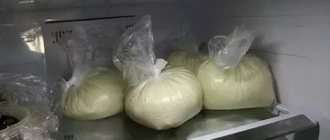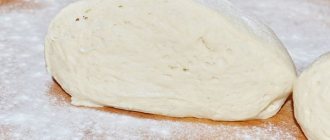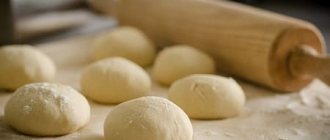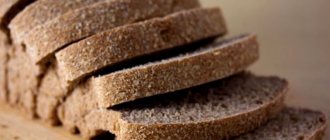There are different opinions regarding the quality of dough products that have been stored. Most people think it's best to start baking immediately after mixing. Others notice that after deep freezing, the dough becomes especially soft and elastic. Be that as it may, if you follow simple storage rules, the finished products will be fluffy and tasty.
Source: depositphotos.com
Every housewife knows that yeast dough becomes airy thanks to the work of microorganisms - single-celled fungi (yeast). Yeast "awakens" when it is placed in a mixture of liquid and sugar. To create the best conditions for fermentation, place the container with the dough in a warm place without drafts, cover the top with a cloth, leaving access to oxygen. At positive temperatures, the fermentation process that has begun cannot be stopped, so unused baking material quickly peroxides and becomes unsuitable for use.
How to store yeast dough? We will share secrets that will help not only save unused leftovers, but also prepare the basis for baking in future, so as not to waste time on kneading each time.
Where to store the dough
The finished product has its own requirements for storage conditions. In the kitchen, the mixture expires after 1-2 hours. There are two places where you can store the product for a long time. This is a refrigerator and a freezer. Each type of semi-finished product requires special storage conditions, time and temperature.
In a refrigerator
According to the state standard, raw dough can be kept on the refrigerator shelf from 9 to 36 hours. The exact time depends on the type of product or its components. Before you put the semi-finished product on the shelf, you should learn how to properly store the dough in the refrigerator.
- Only small amounts of raw food can be stored on the refrigerator shelf.
- The mass must be thoroughly mixed, collected into one lump, and greased with vegetable oil on top.
- The semi-finished product must be wrapped in cling film, parchment, or placed in a bag. In the case of a yeast mixture, it is very important to leave a small hole for oxygen to enter.
- The mass is placed on the shelf where the temperature is lowest.
In the freezer
You can store the raw product at low temperatures from 1 month to six months. In order for frozen dough to retain its taste, the following conditions must be met.
- The semi-finished product must not be thawed or re-frozen. It is better to divide the mass into parts for one-time use.
- It is necessary to form a dense lump or roll from the mass. A thin layer will quickly lose quality, and products made from such a product will not be tasty.
- All types of semi-finished products must be kept in airtight containers or bags. To avoid sticking, the walls of the container should be treated with refined vegetable oil.
Refrigerator storage methods
Sometimes it is difficult to calculate the required proportions of dough and filling for baking, and during the cooking process, excess remains. And here the question arises: can the dough be stored in the refrigerator? If you follow the rules and do not exceed the recommended storage periods, then this option is quite possible.
Option 1
If it is necessary to interrupt the dough preparation process for up to 24 hours, the dough can be placed in the refrigerator and stored at a temperature of +5...8 ℃. It can be:
- yeast diluted with liquid;
- kneaded dough (regardless of whether it has had time to rise or not);
- formed products.
Before sending to the refrigerator, the dough must be thoroughly kneaded - this will help remove excess carbon dioxide. Then roll into balls, sprinkle with flour and place in a deep container (bowl, container). The container should be covered with cling film, making holes in it so that the dough can “breathe”.
Do not forget that the dough will continue to grow in the refrigerator: choose a deep container for storage that is approximately 2 times the volume of the dough
Unleavened yeast dough is more suitable for storage in the refrigerator. Sugar in the dough accelerates the fermentation process: such a product can only be left until the morning, but it is better to freeze it immediately.
Option 2
If you are not sure that you will find time to prepare the baked goods tomorrow, and there is a need to leave the dough for more than 1 day, then the dough can be placed in bags and stored in the refrigerator at a temperature no higher than +3 ℃ (no more than 2 days).
In this case, it is important to remember the following nuances:
- To maintain the temperature regime, the dough must be placed in the coldest part of the refrigerator - the freshness zone - or placed on the middle shelf, closer to the wall. In these places the temperature is +1…3 ℃;
- in the cold, the fermentation process of yeast cultures does not stop, but only slows down, so it is important not to exceed the specified storage periods. Otherwise, the dough will ferment and sour.
The dough must first be kneaded, rolled into balls, greased with vegetable oil, and then placed in dense plastic bags that are 2 times the size of the dough (if there is not enough space in the bag, the dough will simply tear it and flow out). Tie the bags and make holes in them for ventilation.
How to store yeast dough in the refrigerator after rising? Knead thoroughly, grease with vegetable oil, place in a tight plastic bag with a volume of 2 times the dough. Tie the bag and make several holes in it so that the dough can “breathe.” Store in the coldest part of the refrigerator for no more than 12-16 hours.
If the storage conditions have been violated and the dough has fallen or slightly fermented, it will not produce fluffy baked goods. Use it for deep frying (such as making pies, donuts, etc.)
To use the dough after storing it in the refrigerator, you need to remove it from the bag, place it on a board sprinkled with flour and shake it out well. Then place in a bowl, cover with a towel and leave warm until risen.
Factors affecting storage
So, it is clear that yeast dough is very capricious and does not like long-term storage anywhere, even in the “minuses”. Its shelf life depends on:
- storage temperatures;
- degree of readiness;
- presence of sugar in the composition.
Sweet mass intended for baking spoils the fastest. Even frozen butter dough can be stored for no more than thirty days. This is provided that it was not even partially defrosted. If you defrost it, there are two options: either put the baked goods in or throw them away. Yeast dough cannot withstand repeated freezing for future use. Unleavened dough “lives” longer, but it is better to use it as soon as possible.
General storage table
| Type of test | Room temperature (hours) | Refrigerator (days) | Freezer (months) | Recommended cookware |
| Yeast (sour) | 1 | 1-2 | 2-3 | Plastic bag |
| Fresh (yeast-free) | 1 | 2-3 | 6 | Cling film |
| Puff | 1 | 1-2 | 1-2 | Cling film, container |
| Puff pastry without yeast | 2 | 2-3 | 1 | Cling film, container |
| Custard | 1 | 3 | 1 | Cling film |
| Sand | 3-4 | 2-3 | 2-3 | Cling film, bag |
| Biscuit | 1 | 3 | 6 | Container with lid |
| Pancake | 2-3 | 1 | 1 | Pan, container |
What SanPiN says about dough storage
Compliance with food storage rules is regulated by SanPiN standards. According to the document, the deadline for selling the finished dough cannot exceed 9 hours at a storage temperature of 4±2°C.
For lean yeast dough, this figure increases to 24 hours.
Tips for choosing a frozen product
Despite the similarity of cooking recipes, the dough on the shelves of grocery stores differs from each other in its quality. Manufacturers use different technologies and products of different quality.
Good dough can be easily identified by its sealed packaging. If the packaging is damaged, opened, or has been opened, the product may be spoiled.
The entry of air can lead to chapping or loss of beneficial properties; the yeast mass in an open package is unlikely to rise during cooking.
The product packaging must indicate the date of manufacture, shelf life and freezing method. In the absence of such information, you cannot count on purchasing a high-quality useful product. Fresh makes better baked goods. During long-term storage, the product changes its texture and acquires an additional specific odor.
The product will be more delicious if the dough has as many layers as possible. Data on the number of layers must also be indicated on the product packaging. The yeast product contains 35 leaves, the yeast-free product contains more than 200.
It is recommended to familiarize yourself with the composition of the product. It can be found on the product label. A good product does not contain many ingredients or preservatives.
The cost of the product cannot be cheap, since the ingredients included in the composition cannot be cheaper than the final product, i.e. the dough itself. Low prices can be achieved by reducing the quality of the products used.
The packaging material must be as transparent as possible, without any inscriptions or large-scale drawings covering the product.
A high-quality product inside the package moves freely, is uniform in composition, dry and does not stick.
On the product label you can find the technology for defrosting this product. Its absence indicates the negligence of the manufacturer, who did not think about his customers, and therefore does not take responsibility for possible changes when the goods are defrosted.
Shelf life of yeast dough in the freezer
You can store the product in the freezer for 2-3 months. In this case, the temperature must be maintained within -15-18°C. A longer storage period will lead to freezing of the product, due to which it will lose its taste and will not rise after defrosting.
The product purchased in the store is stored longer - 4-5 months, due to the presence of preservatives in the composition. Its storage temperature is -18°C and below.
Where and how to store yeast dough, if there is any left
The product must be stored in the refrigerator and also in the freezer without any consequences, but at the same time observing the required temperature conditions and packaging requirements.
This beneficial property of the dough is due to the fact that its base is represented by flour with water or milk and other dairy products. Flour is “not afraid” of temperature changes, and liquid freezes and melts without any problems. Yeast does not die during freezing, but slows down the fermentation process or even stops it until the temperature of the product rises. Even at low temperatures (not lower than 0°C), they, albeit slowly, continue to ferment. It is precisely because of the last factor that it will not be possible to preserve the dough in the refrigerator for a long time; for this it is better to freeze it.
Storing yeast dough in the refrigerator after rising
If our dough has “arrived”, then saving it after rising is quite simple; you only need to know a few rules.
Method 1
This method is suitable when you intend to store the dough for no more than a day:
- You need to mix it well to remove excess carbon dioxide from the dough.
- It is necessary to form a small piece of the mass and lightly grease it with vegetable oil. If there is a lot of product, then it is better to divide it into portions.
- We choose a container where we will put our dough. It should be deep, approximately 2 times the volume of the product, since in the refrigerator the dough will continue to rise, although this process will be a little slower. We will cover the top of the dishes with film or a plastic bag, and we need to make a hole so that our mass can breathe. This storage option is suitable when the yeast dough will be stored for no more than 1 day.
Method 2
The second method will be better if the dough requires more storage time. The principle of preparation for storage is repeated:
- Mix our dough.
- Divide into shares if there is a lot of product, and grease with a thin layer of oil.
- We place it in a plastic bag and put it in the coolest place in the refrigerator. Typically, this location is located at the back of your refrigerator. There should be enough space in the bag, because the product can tear the cellophane and “run away” onto the refrigerator shelves, as the mass will still increase in size.
Once chilled, the dough is easy to prepare for cooking. It is enough just to mix it well and put it in a warm place until it rises.
It is worth considering that butter dough has a shorter shelf life, unlike unleavened dough. Due to the large amount of sugar in it, the dough begins to ferment faster. Therefore, it is recommended to use the sweet mass on the day of preparation or the next.
How long does yeast dough last in the refrigerator?
The shelf life of yeast dough in the refrigerator depends on the chosen storage method and temperature conditions:
| Storage method | Temperature | Shelf life |
| In container | +5-8°С | Up to 24 hours |
| In the package | +1-3°С | Up to 2 days |
If the permissible storage period is exceeded, the product ferments and sours, does not rise, and when cooked gives the baked dish a strong sour-yeasty smell and an unpleasant taste.
Is it possible to store yeast dough in the freezer?
For long-term storage we use freezing. We freeze fresh, only kneaded product, do not put in the freezer something that has been in the cold for some time, otherwise it will not be able to rise after defrosting.
Knead the dough well, divide into small portions, roll in flour or coat with butter and wrap in a sealed bag. To save, you can also take special ziplock bags or cling film. When storing in the latter, there is no need to lubricate the product with oil. To make it freeze faster, you can roll it out first. Dividing the dough into small portions is necessary because it cannot be re-frozen.
Advice! We recommend that you indicate the date of freezing and the type of dough prepared on the bags so that you can use it on time.
Freezing and storage of semi-finished products is also possible. To do this, place the prepared buns on a baking sheet and place in the oven for a few minutes. As soon as they rise a little, take them out, cool them, wrap the baking sheet in cling film and put them in the freezer. If necessary, take it out, defrost and bake until fully cooked.
Shelf life of yeast dough in the freezer
You can store the product in the freezer for 2-3 months. In this case, the temperature must be maintained within -15-18°C. A longer storage period will lead to freezing of the product, due to which it will lose its taste and will not rise after defrosting.
The product purchased in the store is stored longer - 4-5 months, due to the presence of preservatives in the composition. Its storage temperature is -18°C and below.
Storing yeast dough at room temperature
At a temperature range of +20 to +25°C, the dough cannot be kept for a long time due to the fermentation processes occurring in it. Therefore, the shelf life of the finished product at room temperature is about two hours. If the dough sits for longer, it acquires a sour-bitter taste and becomes unsuitable for cooking.
Defrosting rules
The best options for thawing dough are in the refrigerator or at room temperature. After 2-3 hours, put it on the surface, knead, put in a bowl, cover with a towel and leave in a warm place to rise.
It is also possible to use faster methods:
- on the stove/battery/heater and other heating devices. Place the dough in the pan, cover with a lid and place the pan on or near a heat source;
- in warm water. Without removing the product from the bag, immerse it in warm water. We periodically change it or heat it up;
- in the microwave. Set the “Defrost” mode and select the required time. We do not recommend using this option, since there is a high risk of the product overheating or chapping.
Cold dough recipe
The dough prepared according to this recipe is not “afraid” of drafts and fits well even in the refrigerator. And baked goods prepared on its basis are very tasty and aromatic. Cooking with:
- dry instant yeast – 22 g;
- flour – 10 tbsp;
- eggs – 4 pcs.;
- butter – 400 g;
- milk – 2 tbsp.;
- sugar – 1 tbsp. for sweet pastries, 2 tbsp. for savory;
- salt – 1 tsp.
How to cook:
Heat the milk a little until it is warm, pour it into a bowl and mix with the eggs. Melt the butter, cool slightly until warm and add to the milk-egg mixture. Add sugar and salt, mix well and add yeast. Sift the flour, mix it into the mixture in parts, knead the dough thoroughly. Transfer it to a bag and put it in the refrigerator for 2 hours.
How long does yeast dough last in the refrigerator?
The shelf life of yeast dough in the refrigerator depends on the chosen storage method and temperature conditions:
| Storage method | Temperature | Shelf life |
| In container | +5-8°С | Up to 24 hours |
| In the package | +1-3°С | Up to 2 days |
If the permissible storage period is exceeded, the product ferments and sours, does not rise, and when cooked gives the baked dish a strong sour-yeasty smell and an unpleasant taste.
Storage Features
There are a very large number of varieties of dough, and each of them requires special conditions. In the refrigerator, the raw product is stored at a temperature of 3 to 7 degrees. It is preferable to keep the semi-finished product on a shelf with zero temperature.
The freezer requires preparation for storage. The mass needs to be kneaded well, rolled into a ball, greased with oil or sprinkled with flour. The raw mixture is stored in bags or closed containers. Deep freezing assumes a temperature of -5 to -15 degrees. It is not advisable to store any product in the freezer for longer than 6 months.
Every housewife should have the habit of putting stickers with the date of manufacture on the packaging. This will help determine exactly how long you can store the desired product.
Ready
Sometimes it is convenient to store the dough in the form of semi-finished products.
For this purpose, you need to mold the products, put the filling, and put them in the oven. Bring the product to a semi-prepared state and cool. Wrap each pie in film and freeze.
The shelf life of such semi-finished products is up to 3 months.
Prepared choux pastry products are stored at a temperature of 0 to 6 degrees for about 3 days, and in the freezer for 1 month.
The biscuit is frozen, wrapped in parchment. Before use, the product is heated in the oven.
Cakes for honey cake or Napoleon are covered with foil and kept in the refrigerator for 3 days.
Sand
The dough, which is called shortbread, comes in two types: regular and chopped. The latter option must be used immediately after preparation.
Shortbread dough keeps well refrigerated for up to 36 hours, or frozen for up to 3 months. Products made from frozen or chilled semi-finished products have a more crumbly and crispy structure than those from a fresh product.
Puff
Preparing puff pastry requires a lot of effort and time from the housewife. There is a natural desire to prepare such a semi-finished product for future use. Its structure is provided by the presence of fats. To maintain quality characteristics, it is very important to comply with all requirements.
Chilled sheets are suitable for use for 2-3 days.
The shelf life of this product at sub-zero temperatures depends on the ingredients in the composition. If butter was used to prepare the semi-finished product, it can be stored for 30 to 50 days.
Dough containing only vegetable oil or margarine can be kept in the freezer for up to 6 months.
Particular attention should be paid to protecting the product from moisture. For better results, roll the sheet and wrap it in film.
Custard
Since this product does not have a dense structure, it is worth choosing a container with a tight lid to store it. Before placing the mixture in a bowl, it is worth transferring it into a bag. This will better retain moisture.
The container can remain in the refrigerator for up to 3 days. On the first and second days the dough will have good performance; by the third day it will not spoil, but will be stale.
Frozen choux pastry retains its quality for up to 30 days.
Fresh for dumplings, dumplings and noodles
Kneaded unleavened dough in the kitchen quickly becomes unusable. The mass should be rolled into a tight ball, sprinkled with flour, or covered with refined oil and placed in a bag or hermetically sealed container.
A product that is stored at zero temperature can be used for the first three days. On the fourth day it can no longer be cooked.
Frozen dough for dumplings or dumplings retains its quality for up to 180 days.
Dumpling dough can be used to make flatbreads, bread, or fried in a frying pan.
For pizza
Pizza crust can easily be purchased frozen at the store.
Kept at -18°C for 6 months. After defrosting, you must immediately use it in cooking.
Homemade mass has a similar shelf life. Before placing in optimal conditions, roll out the dough material into a circle on the table and place it on a cutting board in the freezer. This will save time on cooking in the future.
For pancakes
The yeast mixture for pancakes is not stored, but is immediately used for its intended purpose. If you leave it for a while, it will begin to sour, which will affect the taste of the baked goods.
Biscuit
Due to the large number of eggs, the biscuit dough is not left in the refrigerator for a long time (1-2 days in an airtight container).
To ensure that the baked goods rise and the sponge cake turns out airy and tender, it is recommended to bake from freshly prepared material. Do not freeze.
Curd
The dough to which cottage cheese is added is suitable for use for 3 days if it lies on the refrigerator shelf.
If there is a need to store the semi-finished product longer, the mass can be frozen. This way it can be stored for 3 to 6 months. The mixture is rolled into a tight ball and wrapped in cling film. Another storage option involves making dough pieces, freezing them individually, and then putting them in a bag.
Butter
When frozen, it suffers and loses its sweetness, aroma, and taste. It is not recommended to keep it frozen. The semi-finished product is placed in the chamber only in extreme cases. It should not be stored for longer than two months. The optimal temperature is not higher than -18 °C. For example, raw meat lasts much longer in the freezer.
Butter baked goods tolerate storage in the chamber very well. After thawing or heating in a microwave oven, it practically does not change its properties and delights with taste and aroma.
Lagmannoe
Prepared lagman noodles can be placed in a bag, blocking the air supply, and kept at zero temperature for up to 3 days. Before use, just pour boiling water over it.
The storage conditions for raw lagman dough are no different from unleavened dough.
For Napoleon
The best option for storing Napoleon dough is to bake the cakes, wrap them in parchment and keep them on the refrigerator shelf for 3-4 days, and in the freezer for 90 days.
Rolled out
The dough, which has already been rolled out into a thin layer, can be sprinkled with flour and stored in the refrigerator without access to air.
To store at sub-zero temperatures, each individual tortilla should be frozen individually and dusted with flour.
For waffles
The mixture from which waffles are baked has foam. It shrinks very quickly, for this reason it is not advisable to keep such a product for a long time. In a closed container, the mass is stored for up to 48 hours.
On kefir
Batter made with kefir and soda can only be stored in the refrigerator for no longer than 48 hours. At low temperatures it delaminates.
Yeast mass on kefir is suitable for use for up to 2 days at zero temperature, and when frozen for about 3 months.
Pancake
The dough for pancakes (or pancakes) has a pourable, liquid consistency and contains milk (or kefir), eggs, sugar, and baking powder.
Therefore, it should be kept at a temperature of +2+4°C for no more than 24 hours.
The container with the contents must be covered with a lid or plastic wrap and stirred periodically, thereby reducing the risk of thickening and separation of the ingredients.
For chebureks
The minimum amount of ingredients in the composition allows you to keep it at t +4°C for 4-5 days, and at t -18°C for up to 180 days.
It is convenient to roll into small balls up to 15 cm in diameter, sprinkle with flour, place in bags and freeze. It’s easy to make pasties and belyashi from these balls.
Phyllo
Phyllo (fresh extracted yeast-free) comes from Greece, its peculiarity is its thin rolling, the thickness of the layer is no more than 1 mm. You can make your own phyllo or buy it at your local supermarket. The most common product on sale is a frozen product, the shelf life of which in the freezer reaches six months.
After defrosting, the unopened package may be placed in the refrigerator for no more than 72 hours.
Salty (for modeling)
Used as a material for creativity. In kindergartens and schools, figurines, crafts, puppet theater props and much more are made from it. Natural composition, ease of preparation, cost-effectiveness - these are the main advantages of the salted mass. The presence of a large amount of salt as a preservative contributes to the long-term storage of such a batch.
In the refrigerator, the duration reaches 4 weeks if placed in cling film. Eating is prohibited.
How to prepare grape leaves for dolma for the winter
Grape leaves have long been popular in oriental cuisine, due to their specific pleasant taste and beneficial properties. It has been proven that the consumption of such an ingredient relieves pain from varicose veins, relieves swelling, stimulates blood circulation, and enriches the body with valuable vitamins and microelements.
It is important that during long-term storage the product retains the maximum amount of useful substances in its composition, therefore, of the existing methods, many housewives prefer freezing.
Interesting: What to Do with Fermented Apple Juice
For these purposes, it is better to choose young specimens of medium size with small veins. It is better to choose the 5th–7th leaf from the top of the vine.
The following foliage is considered unsuitable for cooking:
- from wild (maiden and ornamental) grapes;
- affected by sunburn, mold, fungi and pests;
- with a suspicious yellowish, whitish or cream color;
- old (dangerous due to components harmful to human health);
- growing on a vine near busy roads and industrial production.
Did you know? Dolma has become the source of international controversy: the Azerbaijan National Culinary Center has accused Armenia of “appropriating” the dish, and recently the UNESCO Intergovernmental Committee recognized the traditions of its preparation in Azerbaijan as one of the elements of the intangible cultural heritage of humanity.
Before freezing, it is advisable to prepare the necessary containers. Remember that thin polyethylene and cling film are subject to crumbling under prolonged conditions of low temperatures. In this regard, dense bags are preferred.
Preparing the leaves
To properly freeze grape leaves, you need:
- cut off the ponytails completely;
- thoroughly rinse the workpiece on both sides;
- dry.
Packaging
Dry leaves are stacked on top of each other in 10 pieces and rolled into a roll. In this form, it is packed into bags and sent to the freezer. It is important that there is as little air as possible inside the package. This will protect the product from foreign odors, allow it to cool faster and be better preserved.
Did you know? Dolma was a dish of the court cuisine of the Ottoman Empire.
For proper harvesting, you need to know when to collect and where best to get grape leaves. For dolma, it is preferable to use white grape varieties. Their plate does not have such a jagged edge as the red varieties, and therefore it is easier to wrap minced meat in it. The foliage is collected when the bush is flowering, in late spring or early summer.
Tender leaf blades five through seven are best, if you start counting from the top of the vine. The average size roughly corresponds to the size of the palm: this will be the most convenient way to wrap the filling.
Leaves are cut off before spraying grapes with chemicals. During the summer, you can also carry out pruning, making sure that after treating the plant with fungicides and insecticides, the period specified in the instructions for the drug passes.
Important! Do not eat products from bushes located along highways!
As with any preparation, the quality of the raw materials plays a crucial role, so it is important to understand which leaves can be used for cooking. They should be a uniform green color, without yellowing, spots or signs of pest damage.
There are several ways to prepare food for the winter, the simplest of which is freezing. But the pickled shell has an additional original flavor. Let's consider all possible ways of harvesting grape leaves.
Freezing
Prepared leaves for freezing must be completely dry. Then they do this:
- Place 10–15 leaves and roll them into a tight roll.
- The roll is wrapped in cling film.
- The rolls are placed in a plastic box, since the product will be fragile after freezing.
To prepare dolma, the pieces will need to be defrosted at room temperature or doused with boiling water.
Important! The number of leaves in one roll should correspond to the amount of dolma that is usually prepared at a time.
Bottled storage
This is an original way to keep leaves fresh for a long time. For it you need to prepare empty plastic bottles. The further procedure is as follows:
- Pour a teaspoon of salt and soda into each bottle, add a little water and shake thoroughly so that the mixture covers the entire inner surface. Then the bottle is rinsed with clean water and dried.
- Small stacks of leaves (3–5 pieces) are rolled into tubes and placed very tightly in the bottle, carefully tamping them down with a stick. The bottle must be completely filled. Sometimes a little salt is added at this stage.
- The bottle is pressed down to release all the air and securely closed with a lid.
This container is stored in a dark, cool place for up to 2 years. To prepare, you need to cut the bottle, remove the leaves and fill with cold water. Sometimes a yellowish coating may appear on the surface, which is not a sign of spoilage.
Did you know? In some regions, fig and quince leaves are used to prepare dolma.
Canning
For preservation, it is necessary to properly prepare glass jars and lids. Sterilization of dishes can be done in a pan of boiling water, in a double boiler or slow cooker, in a microwave or oven. Each jar should be treated with hot steam for 20–25 minutes. With this method, the cuttings do not need to be cut; it will be convenient to use them to pull the workpiece out of the jar. Proceed with the prepared leaves as follows:
- The leaves are rolled into a tube and placed tightly in jars, which are then filled with boiling water for 10 minutes. Afterwards, drain the water and fill the jar with boiling water again.
- Add 1 tbsp per liter of water. l. salt and sugar. Bring the mixture to a boil, stirring to dissolve the salt and sugar.
- The water from the cans is drained and filled with a boiling solution.
- The jar is rolled up and gradually cooled.
Interesting: How to make persimmons ripen
This product should be stored in a cool and dark place.
Pickling
Containers for pickling are processed in the same way as for canning. Then do this:
- Place 4-5 peppercorns, 1-2 buds of dried cloves, 1-2 bay leaves at the bottom of the jar.
- Rolled leaves are placed tightly on top of the spices and filled with the same solution as for preservation, with the addition of 2 tbsp. l. 9% vinegar.
- The jar is closed and stored in a cool place for up to three months, and dolma can be prepared from such a preparation in just a few days.
Pickling
Salting consists of placing the product in a solution of table salt. To pickle grape leaves, do this:
- The rolled rolls are placed tightly in a clean container and poured with boiling water. After 10 minutes, the water is drained.
- The saline solution is prepared based on the proportion: 20 g of salt per 1 liter of water. Add the required amount of salt to the drained water, bring the solution to a boil and pour it into the jar.
- Cover the container tightly, cool and store in the refrigerator.
Dry storage
For this method, brine filling is not used, but the container must be sterilized beforehand. The sequence of further preparation of the workpiece is as follows:
- Place 10–12 leaves at the bottom of the jar, press down and lightly sprinkle with salt.
- The next layer is compacted tightly and salted again.
- The filled jar is sterilized for 10–15 minutes in the oven or steamed, and then closed with a lid using a special key.
Grape leaves are an integral part of dolma. And although this oriental dish is in many ways reminiscent of cabbage rolls, traditional for Slavic cuisine, they cannot be replaced with white cabbage. In order to enjoy the spicy taste of the dish all year round, you should prepare the future “wrapper” for the rice and meat filling in advance for the winter. Is it possible to freeze it, and how to do it correctly, find out further from the article.
Grape leaves have long been popular in oriental cuisine, due to their specific pleasant taste and beneficial properties. It has been proven that the consumption of such an ingredient relieves pain from varicose veins, relieves swelling, stimulates blood circulation, and enriches the body with valuable vitamins and microelements.
For these purposes, it is better to choose young specimens of medium size with small veins. It is better to choose the 5th–7th leaf from the top of the vine. This wrapper is easy to work with, which is not the case with wrappers that are too small or too large. Leaves should be picked between late spring and mid-June, when they reach their peak growth. Healthy, well-developed specimens of regular shape without damage or signs of disease are preferred.
Oriental dishes have long been part of our lives. For example, dolma, beloved by many. It is very similar to our cabbage rolls. Only for its preparation they use grape leaves instead of cabbage leaves. Fans of this unusual dish for our area may be interested in how to store grape leaves for dolma so that it can be prepared even in winter.
Let's take a closer look at each of them.
The easiest way to store grape leaves for dolma is to sterilize them and roll them into jars.
- In order for them to retain their qualities for a long time, they are collected in 10-15 pieces and rolled into a tight roll.
- Then, the leaves folded in this way are placed in a glass jar and sterilized for 20 - 25 minutes, having previously closed the lid tightly.
- After the jars have cooled, they are rolled up and placed in a dark and dry place.
- The optimal period for collecting grape leaves is the time when the vine begins to flower.
- It is recommended to use leaves of white grape varieties for preservation, since they differ favorably from others in their sweet and sour taste, which will positively affect the taste properties of dolma, giving the dish a wonderful piquancy. If you decide to use red grape leaves for harvesting for the winter, remember that their disadvantage is their uneven surface and hardness.
- Only young leaves are suitable for dolma, and it is important to cut them from the vine, which is located as far as possible from the roadway.
- Never use damaged or torn grape leaves for preservation. Take only smooth, whole leaves, preferably the same size.
- Cooking time: approximately 35-50 minutes.
- Number of blanks: 3 blanks of 20 leaves.
Interesting: Ground Hot Pepper for Winter Recipes
Storage as semi-finished products
Another option that simplifies preparation. Suitable for small-sized baked goods; standard pies cannot be stored this way. In this case, follow these recommendations:
- Prepare the dough. Form buns or something else, place on a baking sheet.
- Place in a preheated oven. Monitor the process; as soon as the baked goods rise, take them out and let them cool at room temperature.
- Place in the refrigerator for 2-3 hours. After that, pack them into bags of several pieces and put them in the freezer. Store for no more than 8 weeks.
- Before use, remove the required amount, let it thaw at room temperature, then bake.
If you do everything right, the taste of frozen semi-finished products will be almost no different from fresh baked goods. The main thing is to take the products out of the oven on time and not store them for too long. Thus, it is good to prepare not only buns, but also croissants and pizza bases.
To store yeast dough for pies or any other baked goods, you can use the refrigerator or freezer, it all depends on the timing. The main thing is to do everything on time, meet deadlines and use quality ingredients. It’s even easier to bake semi-finished products and then cook them.
Defrosting rules
The best options for thawing dough are in the refrigerator or at room temperature. After 2-3 hours, put it on the surface, knead, put in a bowl, cover with a towel and leave in a warm place to rise.
It is also possible to use faster methods:
- on the stove/battery/heater and other heating devices. Place the dough in the pan, cover with a lid and place the pan on or near a heat source;
- in warm water. Without removing the product from the bag, immerse it in warm water. We periodically change it or heat it up;
- in the microwave. Set the “Defrost” mode and select the required time. We do not recommend using this option, since there is a high risk of the product overheating or chapping.
Defrosting Tips
If errors are made at this stage, even correct storage does not guarantee that the mass will move away and rise normally. There are several ways, but this one works best:
- Remove the portion from the freezer and place in the refrigerator for several hours. The easiest way is to leave it overnight.
- Place in a warm place with a temperature of 23 degrees, cover with a towel, leave until the volume begins to increase, this may take from 5 to 10 hours.
- Knead and use as usual. You can speed up the process like this: place the bag in a bucket of warm water, which needs to be changed about once an hour.
If you don’t have time, use a microwave; in it, the rolled out layer will thaw in a few minutes. But in this case there is a danger that the mass will not rise. So, the pie dough is usually heated; the time is selected experimentally.
How to quickly defrost dough: 5 effective ways
There are several methods for making homemade baked goods from store-bought dough. To please your guests with pies, it is not recommended to place frozen dough in the microwave.
It is believed that in a microwave oven:
- the structure of the product deteriorates,
- its taste changes,
- beneficial properties decrease,
- The temperature rises unevenly.
If time is limited, you can use the microwave. If time permits, it is recommended to use other effective methods.
Below are effective methods:
| Defrosting options | Step-by-step instruction |
| Natural conditions | Remove from the freezer and leave in the kitchen for 3 hours at room temperature. Cover with a towel. When 1.5 hours have passed, the layer needs to be turned over |
| Oven | Preheat the oven to 90 degrees. Place the product on a baking sheet lined with parchment paper. Hold for exactly 3 minutes. |
| Battery (in winter, when heating is on) | Place the dish on the radiator for 2 hours. Turn over every half hour |
| Microwave | Keep the frozen layer in the refrigerator for 45 minutes. Place in the microwave for 10-15 minutes. Remove the dough and turn over every 30 seconds. |
| Water | Fill the pan with cold water, place the semi-finished product tightly packed in a bag. Pack so that no air passes through. After 20 minutes, place the product in warm water. The water method is the most gentle |
Experienced housewives claim that the best (but also longest) method is natural conditions.
Is it possible to re-freeze yeast-free and yeast dough?
Manufacturers of any frozen dough do not recommend re-freezing the product. This information is indicated on the product packaging.
After the initial defrosting, the product loses some of its normal properties: in yeast dough, a certain amount of fungi die, which are responsible for raising the dough, puff pastry loses its “layeriness,” and “Filo” becomes weathered and sticks together.
To avoid re-freezing or preparing a low-quality dish from such dough, it is recommended to calculate the required volume of the product and not defrost excess.
If necessary, you can cut off a piece of frozen dough (thaw it a little), and seal the rest of it tightly and put it in the freezer.
The safest ways to defrost dough require a lot of time. Only they can guarantee the preservation of all the necessary properties in the dough, its structural and taste qualities. It is impossible to prepare a good tasty dish if the technology for defrosting the dough is broken. When choosing a method that is convenient for you, keep in mind that many types of dough are defrosted in different ways.
How to determine delay
To avoid misunderstandings and not spoil the impression of aromatic baked goods, adhere to the following recommendations:
- When purchasing a factory product, pay attention to the date of manufacture: choose the most recent product.
- The presence of a sharp sour or unpleasant odor indicates that the dough has lost its consumer value and has deteriorated.
- Make sure that the packaging is intact when purchasing: do not take it if it is swollen.
- Pay attention to the composition: if yeast, eggs, sugar are present, it will spoil faster.
- The appearance of a white slimy coating is characteristic of overdue delivery.
Storage recommendations
Basic rules for extending consumer properties at home:
- Ideally placed on the bottom shelf of the refrigerator or in the freshness area.
- If you realize that you won’t have time to sell the test material before tomorrow, place it in the freezer.
- It is first recommended to cut into pieces, roll in flour or brush with vegetable oil.
- The container must reliably protect the contents from the penetration of foreign odors and airing.
- In order to rationally allocate time, you can prepare a large number of semi-finished products (dumplings, cheesecakes, dumplings) and freeze them in portions.
Sources
- https://myff.ru/hranenie/kak-hranit-drozhzhevoe-testo-skolko-mozhno-hranit-takoe/
- https://DomPomora.ru/hranenie/skolko-hranitsya-drozhzhevoe-testo-v-holodilnike.html
- https://kakxranit.ru/produkti/kak-xranit-drozhzhevoe-testo.html
- https://Otbelim.com/hranenie/drugaya-produktsiya/kak-hranit-drozzevoe-testo.html
- https://essens-market.ru/eda-i-napitki/kak-razmorazhivat-testo.html
- https://zagotovki-nazimu.ru/kak-hranit-drozhzhevoe-testo.html
- https://vash-holodilnik.ru/hranenie-produktov/kak-xranit-drozhzhevoe-testo-v-xolodilnike.html
- https://trg-market.ru/tehnika/srok-godnosti-sloenogo-testa.html
- https://profhranenie.ru/kak-hranit-drozhzhevoe-testo
- https://namenu.ru/b4576/Skolqko_mozhno_hranitq_drozhzhevoe_testo_v_holodilqnike_i_mozhno_li_ego_zamorazhivatq
- https://trg-market.ru/tehnika/kak-razmorozit-sloenoe-testo.html











